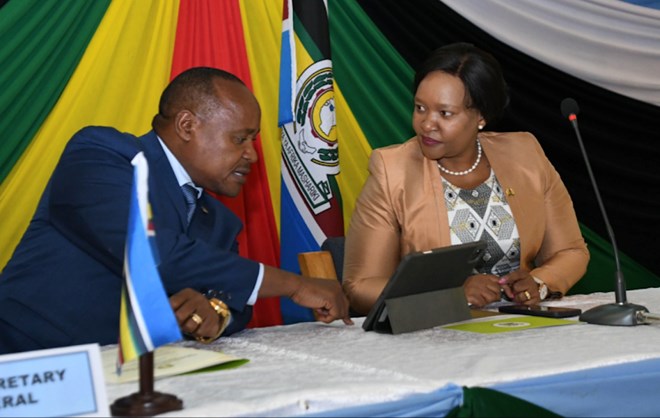
Wednesday August 23, 2023

EAC secretary general Peter Mathuki with Kenya’s EAC, Arid and Semi-Arid Lands and Regional Development CS Rebecca Miano during commencement of negotiations between EAC and Somalia, in Nairobi, on August 22 /EAC
Somalia could finally join the East African Community by end of this year, the secretariat now says, in what will end more than a decade of waiting.
This comes as the on-boarding process enters the final stretch with negotiations kicking off in Nairobi on Tuesday, a process that the EAC Heads of States want expedited.
It follows a successful verification of the Federal Republic of Somalia’s readiness to join the Community.
This was between January and February where experts from member states were in Mogadishu to establish the country’s level of conformity with the criteria for admitting foreign countries, as provided in the Treaty for the establishment of the EAC.
The team assessed Somalia’s development strategies and plans in key areas of collaboration including infrastructure, energy, education and science, peace and security, and international cooperation.
It also looked at institutional frameworks in place; legal frameworks, policies and expectations from membership.
During the last Heads of State Extra-Ordinary Summit in Bujumbura, Burundi, on February 4, the member states agreed to fast track the process of on-boarding Somalia.
Negotiations have hence kicked off with a target of providing completion by end of November, before the next Heads of States Summit.
According to the EAC secretary general Peter Mathuki, this is the final stage before a report is tabled before the Council of Ministers, and then the Summit set for November 30, a time that Somalis is expected to join the EAC.
Agriculture, livestock rearing, forestry, and fishing remain key driver of the economy.
With a GDP of Sh1.1 trillion, Somalia is keen to revive its manufacturing sector, construction, aviation industry, telecommunication and media and financial sector.
In August last year, the Somalia Stock Exchange singed an MoU with Kenya’s Nairobi Securities Exchange to assist it in technical development.
The agreement included identifying appropriate expertise and support as it sought to build up sharia compliant sukuk bonds and halal equities.
It will be the sixth largest economy interms of GDP, after Kenya, which is leading the region with an estimated Gross Domestic Product of $114.7 billion (Sh 16.6 trillion), Tanzania (Sh 11.2 trillion), DRC (Sh 7.3 trillion), Uganda (Sh6.7 trillion) and Rwanda (Sh 1.7 trillion).
South Sudan’s GDP is estimated at Sh823.7 billion while Burindi’s is at about Sh491.3 billion.
Somalia is also believed to have huge oil deposits with its vast coastal line positioning it as a major fish supplier in the region, where countries like Kenya have been importing fish from China.
According to the EAC secretariat, it will bring immense benefits for the EAC through the exploitation its blue economy resources, as it boasts of a coastline of up to 3,300 kilometres, the longest in Africa.
The value of trade between Somalia and her immediate neighbour Kenya was at Sh99.2 billion last year, Kenya’s Economic Survey indicates, which was a drop from Sh106.9 billion the previous year.
Somalia first applied to join the EAC in 2012 and an approval given by the Heads of States Summit in 2013, but the process collapsed.
This was blamed on political instability in the country.
According to the treaty establishing the EAC, new members are admitted if they respect the principles of democracy, rule of law, accountability, transparency and social justice.
Somalia’s Minister of Planning, Investment, and Economic Development Mohamud Abdirahman however yesterday affirmed the country’s readiness to join the EAC.
“The difference I see now is the political goodwill not only from Somalia but the whole of the EAC region. Somalia has huge resources that would contribute to regional growth,” he said.
He also termed the Somalia community as “entrepreneurial” hence would contribute a lot to the EAC and equally benefit from being part of the bloc.
“We have been asked to fast-track and be ready before the end of the year,” Kenya’s EAC Cabinet Secretary Rebecca Miano said.
She noted that there are huge opportunities in trade, human capital and political stability, even as the region seeks to build a strong footing going into the African Continental Free Trade Area.
With an estimated population of 17 million, it will take the East African bloc’s market population to more than 317 million, making it a strategic trading bloc owing to its already integrated systems.
The value of EAC total trade with other markets increased by 13.4 percent to $74.1 billion Sh10.7 trillion) in 2022, from $65.3billion (Sh9.5 trillion) in 2021, official data shows.
Intra-EAC trade grew by 11.2 per cent to $10.9 billion (Sh 1.5 trillion) from $9.8 billion (Sh1.4 trillion).